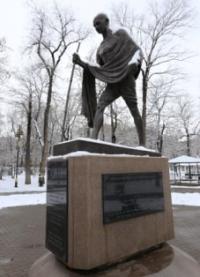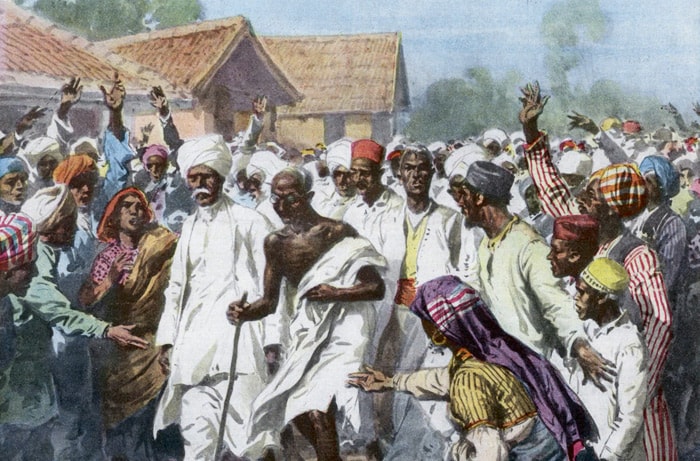You are here
Monument to Makhatma Gandhi in Almaty.

History monument in Almaty.
“The principle of an eye for an eye will make the whole world blind. If you want to see a change in the world, become one”
Sculptural sights of Almaty.
The monument to Mahatma Gandhi in Almaty was erected in October 2003. The monument to the Indian politician Mahatma Gandhi is located in the Almalinsky district of Almaty in a small park in the square of Shevchenko, Gagarin, Dzhambul and Zharokov streets.
The granddaughter of Gandhi, Sumitra Kulkarni, arrived at the opening ceremony of the monument. The initiator of the opening of the monument was the Indian Embassy, which funded its installation as part of the Days of India in Kazakhstan.
The author of the monument was a sculptor from Mumbai - Gautam Pal. In appearance, it is a copy of the Moscow monument to Mahatma Gandhi of the same author, opened on July 8, 1988 in Indira Gandhi Square.
At the birth of Gandhi (1869 - 1948) was called Mohandas Karanchand. In 1915, with the filing of a Nobel laureate, Rabindranath Tagore, everyone began to call him Mahatma, which means "enlightened", "bearer of truth", "saint."
Gandhi belonged to the caste of artisans and merchants. His father was engaged in business and had some savings, so Gandhi Jr. got the opportunity to get a law degree in London. Returning to his homeland in 1891, he soon left to work in South Africa. It was here that he began to fight for the rights of the Indians who were widely used in mine work.
It was in South Africa that he formulated the main principle of this struggle - non-violent resistance, which implied not only non-violence, but also a willingness to endure pain and suffering. A certain influence on this choice was Leo Tolstoy, with whom Gandhi was in a long correspondence.
In 1920, Gandhi returned to his homeland, where he began to introduce his teachings into the minds of compatriots, quickly gaining popularity among the widest sections of the population. Moreover, he was highly appreciated not only by the Indians, but also by the Muslims who inhabited the vast colony.
Until 1935, Gandhi headed the Indian National Congress. But then, due to political differences, he was forced to leave him. And from that moment he acted independently, being a powerful self-sufficient “institution”, being the spiritual leader of the nation.
March 12, 1930, the spiritual leader of the Indians Mahatma Gandhi in protest against the anti-people laws of the British Empire began the Salt Camp. After it ended, 80 thousand protesters led by the leader ended up in jail. As a result, the Indians became even more established in their desire to gain independence.
In March 2015, near the Parliament building in London, a new monument to Mahatma Gandhi was unveiled. The erection of the monument is dedicated to the 100th anniversary of the return of the Indian spiritual leader to his homeland to begin the struggle for independence from Great Britain.
The opening ceremony was attended by British Prime Minister David Cameron, the grandson of Gandhi politician Sri Gopalkrishna Gandhi. "By erecting a monument to Gandhi in this famous square, we give it an eternal home in our country," said David Cameron.

Authority:
http://weekend.rambler.ru https://ru.wikipedia.org
Photos
Alexander Petrov.







